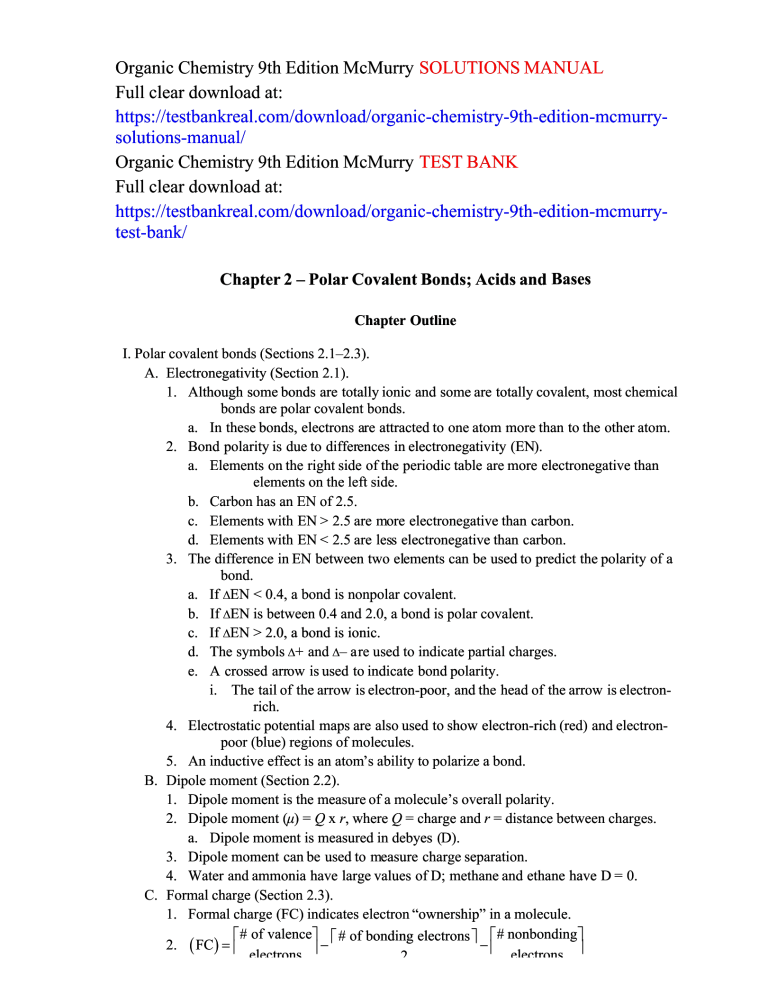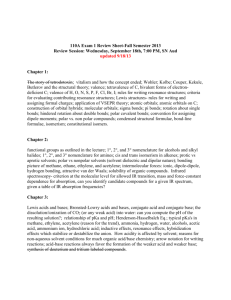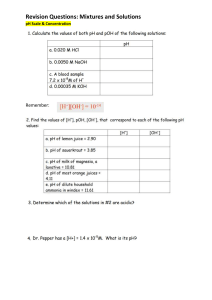
Organic Chemistry 9th Edition McMurry SOLUTIONS MANUAL Full clear download at: https://testbankreal.com/download/organic-chemistry-9th-edition-mcmurrysolutions-manual/ Organic Chemistry 9th Edition McMurry TEST BANK Full clear download at: https://testbankreal.com/download/organic-chemistry-9th-edition-mcmurrytest-bank/ Chapter 2 – Polar Covalent Bonds; Acids and Bases Chapter Outline I. Polar covalent bonds (Sections 2.1–2.3). A. Electronegativity (Section 2.1). 1. Although some bonds are totally ionic and some are totally covalent, most chemical bonds are polar covalent bonds. a. In these bonds, electrons are are attracted to one atom more than to the other atom. 2. Bond polarity is due to differences differences in electronegativity (EN). (EN). a. Elements on the right side of the periodic table are more electronegative than elements on the left side. b. Carbon has an EN of 2.5. c. Elements with EN > 2.5 are more more electronegative than carbon. d. Elements with EN < 2.5 are less less electronegative than carbon. 3. The difference in EN between two elements elements can be used to predict the polarity of a bond. a. If ∆ΕΝ < 0.4, a bond is nonpolar covalent. b. If ∆ΕΝ is between 0.4 and 2.0, a bond is polar covalent. c. If ∆ΕΝ > 2.0, a bond is ionic. d. The symbols ∆+ and ∆– are a re used to indicate partial charges. e. A crossed crossed arrow arrow is used to indicate bond polarity. i. The tail of the arrow is electron-poor, and the head of the arrow is electronrich. 4. Electrostatic potential maps are also used to show electron-rich (red) and electronpoor (blue) regions of molecules. 5. An inductive effect is an atom’s atom’s ability to polarize a bond. B. Dipole moment (Section 2.2). 1. Dipole moment is the measure of a molecule’s overall polarity. 2. Dipole moment (μ) = Q x r, where Q = charge and r = distance between charges. a. Dipole moment is measured in debyes (D). (D). 3. Dipole moment can be used to measure measure charge separation. 4. Water and ammonia have large values of D; methane and ethane have D = 0. C. Formal charge (Section 2.3). 1. Formal charge (FC) indicates electron “ownership” in a molecule. # of valence # of bonding electrons # nonbonding 2. FC electrons electrons 2 II. Resonance (Sections 2.4–2.6). A. Chemical structures structures and resonance resonance (Section 2.4). 1. Some molecules (acetate ion, for example) can be drawn as two (or more) different electron-dot structures. a. These structures are called resonance structures. 22 Chapter 2 Polar Covalent Bonds; Acids and Bases b. The true structure of the molecule is intermediate between the resonance structures. c. The true structure is called a resonance hybrid. hybrid. 2. Resonance structures structures differ differ only in in the placement of π and nonbonding electrons. a. All atoms occupy the same positions. 3. Resonance is is an important concept in organic chemistry. chemistry. B. Rules for resonance forms (Section 2.5). 1. Individual resonance forms forms are imaginary, not real. real. 2. Resonance forms differ only in the placement of their π or nonbonding electrons. a. A curved arrow arrow is used to indicate indicate the movement movement of electrons, electrons, not atoms. 3. Different resonance forms forms of a mo molecule don’t have to be equivalent. a. If resonance resonance forms are nonequivalent, the structure of the actual molecule resembles the more stable resonance form(s). 4. Resonance forms forms must obey normal rules of valency. 5. The resonance resonance hybrid is more stable than any individual resonance form. C. A useful technique for drawing resonance forms (Section 2.6). 1. Any three-atom three-atom grouping with a multiple bond adjacent to a nonbonding p orbital has two resonance forms. 2. One atom in in the grouping has a lone electron pair, a vacant orbital orbital or a single electron. 3. By recognizing these three-atom pieces, resonance forms can be generated. III. Acids and bases (Sections 2.7–2.11). A. Brønsted–Lowry definition (Section 2.7). 1. A Brønsted–Lowry acid donates an H+ ion; a Brønsted–Lowry base accepts H+. 2. The product product that results when when a base gains H+ is the conjugate acid of the base; the product that results when an acid loses H+ is the conjugate base of the acid. 3. Water can act either as an acid or as a base. B. Acid and base strength strength (Section 2.8–2.10). 1. A strong strong acid reacts almost completely with water (Section 2.8). 2. The strength strength of an acid in water is indicated by Ka, the acidity constant. 3. Strong acids have large acidity constants, and weaker acids have smaller acidity acidity constants. 4. The pKa is normally used to express acid strength. a. pKa = –log Ka b. A strong acid has a small pKa, and a weak acid has a large pKa. c. The conjugate base of a strong acid is a weak base, and the conjugate base of a weak acid is a strong base. 5. Predicting acid–base reactions from pKa (Section 2.9). a. An acid with a low pKa (stronger acid) reacts with the conjugate base of an acid with a high pKa (stronger base). b. In other words, the products of an acid–base reaction are more stable than the reactants. 22 23 Chapter 2 Polar Covalent Bonds; Acids and Bases 23 6. Organic acids and organic bases (Section 2.10). 2.10). a. There are two main types types of organic acids: i. Acids that contain hydrogen bonded to oxygen. ii. Acids that have hydrogen bonded to the carbon next to a C=O group. b. The main type of organic base contains a nitrogen atom with a lone electron pair. C. Lewis acids and bases (Section 2.11). 1. A Lewis acid accepts an electron electron pair. a. A Lewis acid may have either a vacant low-energy orbital or a polar bond to hydrogen. b. Examples include metal cations, halogen acids, group 3 compounds and transition-metal compounds. 2. A Lewis Lewis base has a pair of nonbonding electrons. a. Most oxygen- and nitrogen-containing organic organic compounds are Lewis Lewis bases. b. Many organic Lewis bases have more than one basic site. 3. A curved arrow shows the movement movement of electrons from from a Lewis base to a Lewis Lewis acid. IV. Noncovalent interactions in molecules (Section 2.12). A. Dipole–dipole interactions occur between polar molecules as a result of electrostatic interactions among dipoles. 1. These interactions may be either attractive or repulsive. repulsive. 2. The attractive geometry is lower in energy and predominates. B. Dispersion forces forces result from from the constantly changing electron distribution within molecules. 1. These forces are transient and weak, but their cumulative effect may be important. important. C. Hydrogen bonds. 1. Hydrogen bonds form between a hydrogen bonded to an electronegative atom and an unshared electron pair on another electronegative atom. 2. Hydrogen bonds are extremely important in living living organisms. organisms. 3. Hydrophilic substances dissolve in water because they are capable of forming forming hydrogen bonds. 4. Hydrophobic substances don’t form hydrogen hydrogen bonds and usually don’t dissolve in water. 24 Chapter 2 Polar Covalent Bonds; Acids and Bases Solutions to Problems 2.1 After solving this problem, use Figure 2.2 to check your answers. The larger the number, the more electronegative the element. More electronegative (a) H (2.1) (b) Br (2.8) (c) Cl (3.0) (d) C (2.5) Less electronegative Li (1.0) B (2.0) I (2.5) H (2.1) Carbon is slightly more electronegative than hydrogen. 2.2 2.3 As in Problem 2.1, use Figure 2.2. The partial negative charge is placed on the more electronegative atom, and the partial positive charge is placed on the less electronegative atom. (a) (b) (c) (d) (e) (f) Use Figure 2.2 to find the electronegativities of each element. Calculate ΔEN and rank the answers in order of increasing ∆EN. Carbon: Lithium: EN = 2.5 EN = 1.0 ∆EN = 1.5 Carbon: Magnesium: EN = 2.5 EN = 1.2 EN = 1.3 ∆ Carbon: Potassium: EN = 2.5 EN = 0.8 ∆EN = 1.7 Oxygen: Carbon: Fluorine: Carbon: EN = 4.0 EN = 2.5 ∆EN = 1.5 EN = 3.5 EN = 2.5 EN = 1.0 ∆ The most polar bond has the largest ΔEN. Thus, in order of increasing bond polarity: H3C — OH < H3C — MgBr < H3C — Li, H3C — F < H3C — K 24 25 Chapter 2 2.4 Polar Covalent Bonds; Acids and Bases In an electrostatic potential map, the color red indicates re gions of a molecule that are electron-rich. The map shows that chlorine is the most electronegative atom in chloromethane, and the direction of polarity of the C–Cl bond is: Chloromethane 2.5 Ethylene glycol The dipole moment of ethylene glycol is zero because the bond polarities of the two carbon–oxygen bonds cancel. 2.6 2.7 For each bond, identify the more electronegative element, and draw an arrow that points from the less electronegative element to the more electronegative element. Estimate the sum of the individual dipole moments to arrive at the dipole moment for the entire molecule. (a) (b) (c) (d) To find the formal charge of an atom in a molecule, follow these two steps: (1) Draw an electron-dot structure of the molecule. (2) Use the formula in in Section 2.3 (shown below) to determine formal formal charge for each atom. The periodic table shows the number nu mber of valence electrons of the element, and an d the electron-dot structure shows the number of bonding and nonbonding electrons. # of valence # of bonding electrons # nonbonding electrons electrons 2 Formal charge FC 25 26 Chapter 2 Polar Covalent Bonds; Acids and Bases (a) Remember: Valence electrons are the electrons characteristic of a specific element. Bonding electrons are those electrons involved in bonding to other atoms. Nonbonding electrons are those electrons in lone pairs. (b) (c) 26 27 Chapter 2 Polar Covalent Bonds; Acids and Bases 27 2.8 Oxygen atoms 3 and 4 each have a formal charge of –1, and oxygen atoms 1 and 2 have a formal charge of 0. 2.9 Try to locate the three-atom groupings that are present in resonance forms. (a) These two structures represent resonance forms. The three-atom grouping (C–C double bond and an adjacent vacant p orbital) is pictured on the right. (b) These two structures represent different compounds, not resonance structures. 2.10 Look for three-atom groupings that contain a multiple bond next to an atom with a p orbital. Exchange the positions of the bond b ond and the electrons in the p orbital to draw the resonance form of each grouping. (a) Methyl phosphate anion has 3 three-atom groupings and thus thus has 3 resonance forms. forms. Recall from Chapter 1 that phosphorus, a third-row element, can form more tha n four covalent bonds 28 Chapter 2 Polar Covalent Bonds; Acids and Bases (b) (c) (d) 2.11 When an acid loses a proton, the product is the conjugate base of the acid. When a base gains a proton, the product is the conjugate acid of the base. 2.12 Recall from Section 2.8 that a stronger acid has a smaller pKa and a weaker acid has a larger pKa. Accordingly, phenylalanine (pKa = 1.83) is a stronger acid than tryptophan (pKa = 2.83). 2.13 HO–H is a stronger acid than H2N–H. Since H2N– is a stronger base than HO–, the conjugate acid of H2N– (H2N–H) is a weaker acid than the conjugate acid of HO– (HO–H). 2.14 Use Table 2.3 to find the strength of each acid. A reaction takes place as written if the stronger acid is the reactant. (a) Remember that the lower the pKa, the stronger the acid. Thus CH3CO2H, not HCN, is the stronger acid, and the above reaction will not take place to a significant ex tent in them direction written. 28 29 Chapter 2 Polar Covalent Bonds; Acids and Bases 29 (b) Using the same reasoning as in part (a), we can see that the above abov e reaction will not occur to a significant extent. 2.15 As written, the above reaction will take place to virtual completion due to the large difference in pKa values. 2.16 Enter –9.31 into a calculator and use the INV LOG function to arrive at the answer Ka = 4.9 x 10–10. 2.17 Locate the electron pair(s) of the Lewis base and draw a curved arrow from the electron pair to the Lewis acid. The electron pair moves from the atom at the tail of the arrow arrow (Lewis base) to the atom at the point of the arrow (Lewis acid).(Note: electron dots have been omitted from Cl– to reduce clutter.) (a) (b) 30 Chapter 2 2.18 (a) Polar Covalent Bonds; Acids and Bases The nitrogen on the left is more more electron-rich electron-rich and and more basic. The indicated hydrogen is most electron-poor (bluest) and is most acidic. (b) 2.19 Vitamin C is water-soluble (hydrophilic) because it has several polar –OH groups that can form hydrogen bonds with water. Vitamin A is fat-soluble (hydrophobic) because most of its atoms atoms can’t form hydrogen bonds with water. Visualizing Chemistry 2.20 Naphthalene has three resonance forms. 30 31 Chapter 2 Polar Covalent Bonds; Acids and Bases 31 2.21 2.22 Electrostatic potential maps show that the electron-rich regions of the cis isomer lie on the same side of the double bond, leading to a net dipole moment. Because the electron-rich regions of the trans isomer are symmetrical about the double bond, the individual bond dipole moments cancel, and the isomer has no overall dipole moment. 2.23 (a) (b) Mechanism Problems 2.24 (a) BF3 O BF3 O 32 Chapter 2 Polar Covalent Bonds; Acids and Bases (b) H I O O H I (c) O H O H N O N O 2.25 (a) H H O O (b) H H O O N H N H (c) N N H H (d) H O H H O H 32 33 Chapter 2 Polar Covalent Bonds; Acids and Bases 33 2.26 (a) NH2 NH2 (b) O O (c) 2.27 (a) Cl H H2C Cl H2C CH2 CH3 (b) H H C Cl Cl H C C H2 C H (c) Cl HC HC HC H2 C H Additional Problems Electronegativity and Dipole Moments 2.28 Use Figure 2.2 if you need help. The most electronegative element is starred. (a) * CH2FC1 (b) * FCH2CH2CH2Br (c) * HO CH2CH2NH2 (d) * CH3OCH2Li 34 Chapter 2 Polar Covalent Bonds; Acids and Bases More polar 2.29 Less polar (a) (b) (c) (d) 2.30 (a) 2.31 (a) (b) (b) (c) (d) In Section 2.2, we found that μ = Q x r. For a proton and an electron separated by 100 pm, μ = 4.80 D. If the two charges are separated by 136 pm, μ = 6.53 D. Since the observed dipole moment is 1.08 D, the H–Cl bond has (1.08 D / 6.53 D) x 100 % = 16.5 % ionic character. 2.32 In phosgene, the individual bond polarities tend to cancel, but in formaldehyde, the bond polarities add to each other. Thus, phosgene has a smaller dipole moment than form aldehyde. 2.33 The magnitude of a dipole moment depends on both charge and distance between atoms. Fluorine is more electronegative than chlorine, but a C–F bond is shorter than a C –Cl bond. Thus, the dipole moment of CH3F is smaller than that of CH3Cl. 2.34 The observed dipole moment is due to the lone pair electrons on sulfur. 34 35 Chapter 2 Polar Covalent Bonds; Acids and Bases 35 Formal Charges 2.35 To save space, molecules are shown as line-bond structures with lone pairs, rather than as electron-dot structures. (a) (b) (c) (d) (e) (f) 36 Chapter 2 Polar Covalent Bonds; Acids and Bases 2.36 As in Problem 2.31, molecules are shown as line-bond structures with lone-pair electrons indicated. Only calculations for atoms with non-zero formal charge are sho wn. (a) (b) (c) Resonance 2.37 Resonance forms do not differ in the position of nuclei. The two structures in (a) are not resonance forms because the positions of the carbon and hydrogen atoms outside the ring are different in the two forms. The pairs of structures in parts (b), (c), and (d) represent resonance forms. 2.38 (a) (b) 36 37 Chapter 2 Polar Covalent Bonds; Acids and Bases 37 (c) The last resonance structure is a minor contributor because its carbon lacks a complete electron octet. (d) (e) 2.39 The two structures are not resonance forms because the po sitions of the carbon atoms are different in the two forms. Acids and Bases 2.40 2.41 The O–H hydrogen of acetic acid is more acidic than the C–H hydrogens. The –OH oxygen is electronegative, and, consequently, the –O–H bond is more strongly polarized than the –C–H bonds. In addition, the acetate anion is stabilized by resonance. 2.42 (a) (b) (c) 38 Chapter 2 (d) Polar Covalent Bonds; Acids and Bases (e) (f) The Lewis acids shown below can accept an electron pair either because they have a vacant orbital or because they can donate H+. The Lewis bases have nonbonding electron pairs. 2.43 (a) (b) (c) 2.44 The substances with the largest values of pKa are the least acidic. 2.45 To react completely (> 99.9%) with NaOH, an a cid must have a pKa at least 3 units smaller than the pKa of H2O. Thus, all substances in the previous problem except acetone react completely with NaOH. 2.46 The stronger the acid (smaller pKa), the weaker its conjugate base. Since NH4+ is a stronger acid than CH3NH3+, CH3NH2 is a stronger base than NH3. 38 39 Chapter 2 Polar Covalent Bonds; Acids and Bases 39 2.47 The reaction takes place as written because water is a stronger acid than tert-butyl alcohol. Thus, a solution of potassium tert-butoxide in water can’t can’t be prepared. 2.48 2.49 (a) Acetone: K a 5 x 10 2.50 (a) Nitromethane: pK a 10.30 20 (b) Formic acid: K a (b) Acrylic acid: pK a 4.25 1.8 x 10 4 2.51 If you let 0.050 – x = 0.050, then x = 3.0 × 10–3 and pH = 2.52. If you calculate x exactly using the quadratic equation, then x = 2.9 × 10–3 and pH = 2.54. 2.52 Only acetic acid will react with sodium bicarbonate. Acetic acid is the only substance in Problem 2.40 that is a stronger acid than carbonic acid. 40 Chapter 2 Polar Covalent Bonds; Acids and Bases General Problems mo ments add to produce a net n et dipole moment for the 2.53 In maleic acid, the individual dipole moments whole molecule. The individual dipole moments in fumaric acid cancel, resulting in a zero dipole moment. 2.54 Sodium bicarbonate reacts with acetic acid to produce carbonic acid, which breaks down to form CO2. Thus, bubbles of CO2 indicate the presence of an acid stronger than carbonic acid, in this case acetic acid, as the pKa values indicate. Phenol does not react with sodium bicarbonate. 2.55 Reactions (a) and (c) are reactions between Brønsted–Lowry acids and bases; the stronger acid and stronger base are identified. Reactions (b) and (d) occur between Lewis acids and bases. (a) (b) (c) (d) 40 41 Chapter 2 Polar Covalent Bonds; Acids and Bases 41 2.56 Pairs (a) and (d) represent resonance structures; pairs (b) and (c) do not. For two structures to be resonance forms, all atoms must be in the same positions in all resonance forms. 2.57 (a) (b) (c) 2.58 The cation pictured can be represented by two resonance forms. Reaction with water can occur at either positively charged carbon, resulting in two products. 2.59 (a) 2.60 (b) (c) (d) 42 Chapter 2 Polar Covalent Bonds; Acids and Bases 2.61 When phenol loses a proton, the resulting anion is stabilized by resonance. The methanol anion is not stabilized by resonance. 2.62 2.63 (a) The central carbon of carbonate ion is sp2 and trigonal planar. The three resonance forms contribute equally to the overall resonance h ybrid. Thus, the molecule has no dipole. O O O O C C C O O O O O 42 43 Chapter 2 (b) Polar Covalent Bonds; Acids and Bases 43 The oxygen is sp3 hybridized and tetrahedral. Therefore, there is a dipole pointing towards the lone pairs. O O H3C CH3 The carbocation is sp2 hybridized and trigonal planar. Thus, there is no dipole. (c) CH3 C(CH3)3 C H3C CH3 2.64 The equilibrium always favors the weaker acid/base pair (acid with t he higher pKa) (a) OH CO2 O + CO2H + pKa 9.9 pKa 4.2 (b) CH3CH2CH2OH pKa + NH2 + CH3CH2CH2O 16.1 NH3 pKa 36 The “a” in pKa here should be subscript. (c) CH3 + CH3NO2 pKa 10.3 CH4 pKa + CH2NO2 60 The “a” in pKa here should be subscript. 2.65 (a) London dispersion forces (b) Hydrogen bonding (c) Hydrogen bonding causes the carboxylic acids interact interact with one another and and that force is stronger than the dispersion forces between acetic acid and oil. 44 Chapter 2 Polar Covalent Bonds; Acids and Bases 2.66 (a) (b) O H2C (d) (c) O O O O 2.67 Being more electronegative than carbon, the three chlorine atoms inductively remove electron density from the carbon atom to which th ey are all attached. This effect propagates down the chain, ultimately reducing the electron ele ctron density on the oxygen. This makes the oxygen-hydrogen bond weaker and the molecule more acidic. Cl Cl C Cl O C H H H Organic Chemistry 9th Edition McMurry SOLUTIONS MANUAL Full clear download at: https://testbankreal.com/download/organic-chemistry-9th-edition-mcmurrysolutions-manual/ Organic Chemistry 9th Edition McMurry TEST BANK Full clear download at: https://testbankreal.com/download/organic-chemistry-9th-edition-mcmurrytest-bank/ john mcmurry organic chemistry 9th edition solutions manual pdf organic chemistry 9th edition mcmurry pdf mcmurry organic chemistry 9th edition pdf free organic chemistry mcmurry 8th edition organic chemistry mcmurry 9th edition pdf download organic chemistry john mcmurry 9th edition pdf free organic chemistry mcmurry 9th edition solutions manual organic chemistry mcmurry 9th edition online 44




